Business and Business Environment Report
VerifiedAdded on 2020/12/29
|14
|3967
|325
Report
AI Summary
This report analyzes Tesco, a multinational grocery retailer, examining its organizational structure, functions, and interrelationships. It includes a PESTLE analysis to assess external macro factors and a SWOT analysis to identify strengths, weaknesses, opportunities, and threats. The report also compares Tesco to Sainsbury and reflects on the impact of key findings on decision-making.
Contribute Materials
Your contribution can guide someone’s learning journey. Share your
documents today.
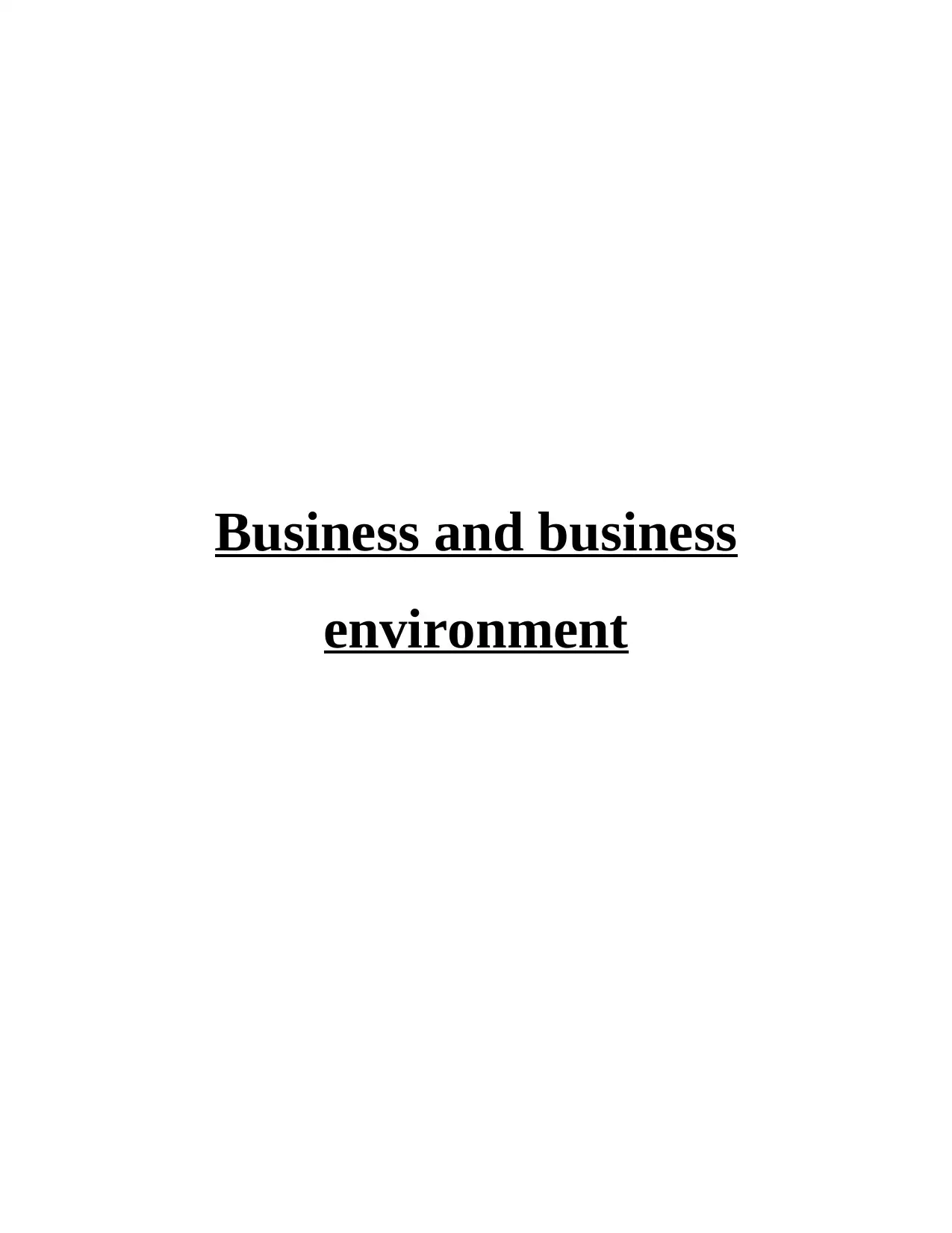
Business and business
environment
environment
Secure Best Marks with AI Grader
Need help grading? Try our AI Grader for instant feedback on your assignments.
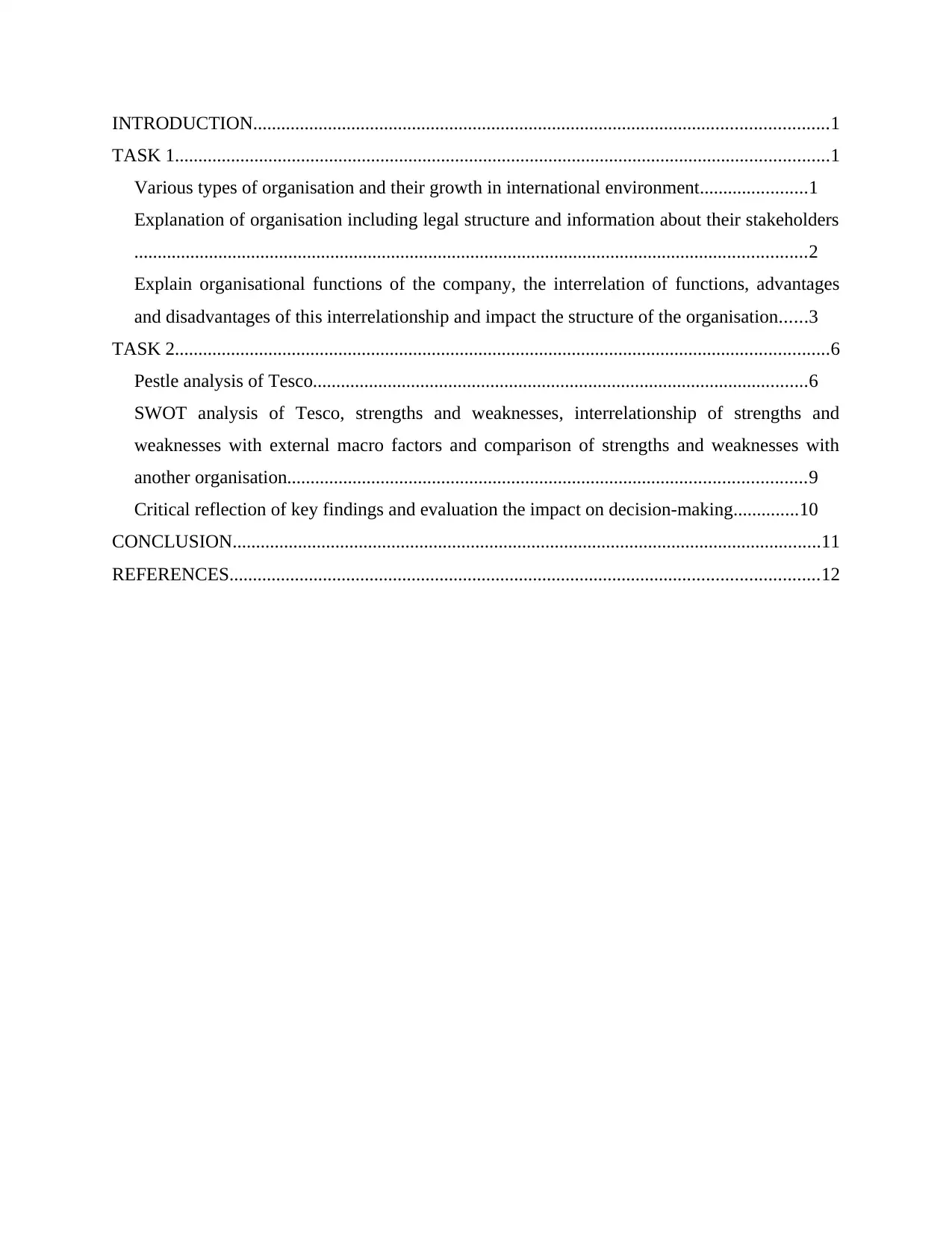
INTRODUCTION...........................................................................................................................1
TASK 1............................................................................................................................................1
Various types of organisation and their growth in international environment.......................1
Explanation of organisation including legal structure and information about their stakeholders
................................................................................................................................................2
Explain organisational functions of the company, the interrelation of functions, advantages
and disadvantages of this interrelationship and impact the structure of the organisation......3
TASK 2............................................................................................................................................6
Pestle analysis of Tesco..........................................................................................................6
SWOT analysis of Tesco, strengths and weaknesses, interrelationship of strengths and
weaknesses with external macro factors and comparison of strengths and weaknesses with
another organisation...............................................................................................................9
Critical reflection of key findings and evaluation the impact on decision-making..............10
CONCLUSION..............................................................................................................................11
REFERENCES..............................................................................................................................12
TASK 1............................................................................................................................................1
Various types of organisation and their growth in international environment.......................1
Explanation of organisation including legal structure and information about their stakeholders
................................................................................................................................................2
Explain organisational functions of the company, the interrelation of functions, advantages
and disadvantages of this interrelationship and impact the structure of the organisation......3
TASK 2............................................................................................................................................6
Pestle analysis of Tesco..........................................................................................................6
SWOT analysis of Tesco, strengths and weaknesses, interrelationship of strengths and
weaknesses with external macro factors and comparison of strengths and weaknesses with
another organisation...............................................................................................................9
Critical reflection of key findings and evaluation the impact on decision-making..............10
CONCLUSION..............................................................................................................................11
REFERENCES..............................................................................................................................12
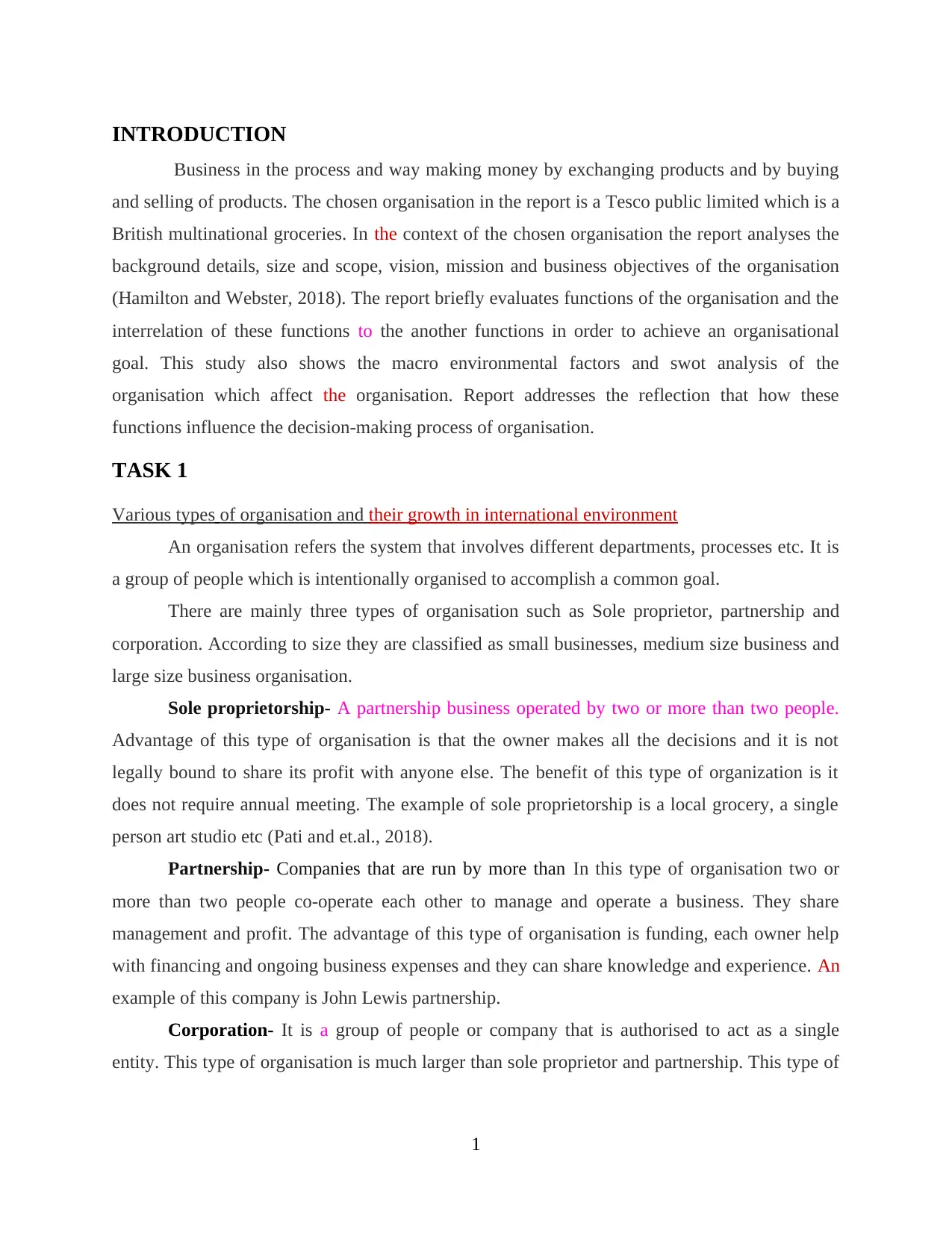
INTRODUCTION
Business in the process and way making money by exchanging products and by buying
and selling of products. The chosen organisation in the report is a Tesco public limited which is a
British multinational groceries. In the context of the chosen organisation the report analyses the
background details, size and scope, vision, mission and business objectives of the organisation
(Hamilton and Webster, 2018). The report briefly evaluates functions of the organisation and the
interrelation of these functions to the another functions in order to achieve an organisational
goal. This study also shows the macro environmental factors and swot analysis of the
organisation which affect the organisation. Report addresses the reflection that how these
functions influence the decision-making process of organisation.
TASK 1
Various types of organisation and their growth in international environment
An organisation refers the system that involves different departments, processes etc. It is
a group of people which is intentionally organised to accomplish a common goal.
There are mainly three types of organisation such as Sole proprietor, partnership and
corporation. According to size they are classified as small businesses, medium size business and
large size business organisation.
Sole proprietorship- A partnership business operated by two or more than two people.
Advantage of this type of organisation is that the owner makes all the decisions and it is not
legally bound to share its profit with anyone else. The benefit of this type of organization is it
does not require annual meeting. The example of sole proprietorship is a local grocery, a single
person art studio etc (Pati and et.al., 2018).
Partnership- Companies that are run by more than In this type of organisation two or
more than two people co-operate each other to manage and operate a business. They share
management and profit. The advantage of this type of organisation is funding, each owner help
with financing and ongoing business expenses and they can share knowledge and experience. An
example of this company is John Lewis partnership.
Corporation- It is a group of people or company that is authorised to act as a single
entity. This type of organisation is much larger than sole proprietor and partnership. This type of
1
Business in the process and way making money by exchanging products and by buying
and selling of products. The chosen organisation in the report is a Tesco public limited which is a
British multinational groceries. In the context of the chosen organisation the report analyses the
background details, size and scope, vision, mission and business objectives of the organisation
(Hamilton and Webster, 2018). The report briefly evaluates functions of the organisation and the
interrelation of these functions to the another functions in order to achieve an organisational
goal. This study also shows the macro environmental factors and swot analysis of the
organisation which affect the organisation. Report addresses the reflection that how these
functions influence the decision-making process of organisation.
TASK 1
Various types of organisation and their growth in international environment
An organisation refers the system that involves different departments, processes etc. It is
a group of people which is intentionally organised to accomplish a common goal.
There are mainly three types of organisation such as Sole proprietor, partnership and
corporation. According to size they are classified as small businesses, medium size business and
large size business organisation.
Sole proprietorship- A partnership business operated by two or more than two people.
Advantage of this type of organisation is that the owner makes all the decisions and it is not
legally bound to share its profit with anyone else. The benefit of this type of organization is it
does not require annual meeting. The example of sole proprietorship is a local grocery, a single
person art studio etc (Pati and et.al., 2018).
Partnership- Companies that are run by more than In this type of organisation two or
more than two people co-operate each other to manage and operate a business. They share
management and profit. The advantage of this type of organisation is funding, each owner help
with financing and ongoing business expenses and they can share knowledge and experience. An
example of this company is John Lewis partnership.
Corporation- It is a group of people or company that is authorised to act as a single
entity. This type of organisation is much larger than sole proprietor and partnership. This type of
1
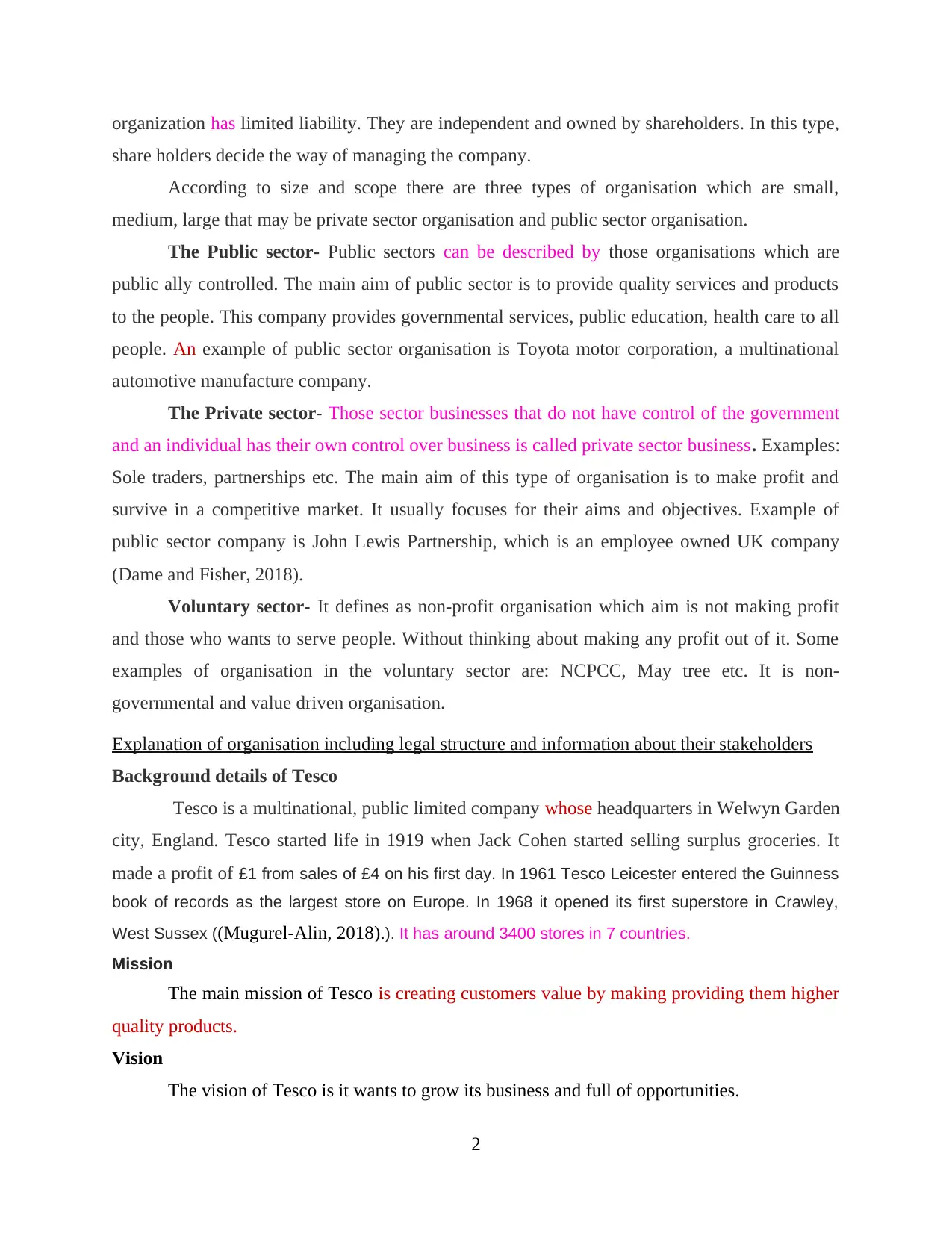
organization has limited liability. They are independent and owned by shareholders. In this type,
share holders decide the way of managing the company.
According to size and scope there are three types of organisation which are small,
medium, large that may be private sector organisation and public sector organisation.
The Public sector- Public sectors can be described by those organisations which are
public ally controlled. The main aim of public sector is to provide quality services and products
to the people. This company provides governmental services, public education, health care to all
people. An example of public sector organisation is Toyota motor corporation, a multinational
automotive manufacture company.
The Private sector- Those sector businesses that do not have control of the government
and an individual has their own control over business is called private sector business. Examples:
Sole traders, partnerships etc. The main aim of this type of organisation is to make profit and
survive in a competitive market. It usually focuses for their aims and objectives. Example of
public sector company is John Lewis Partnership, which is an employee owned UK company
(Dame and Fisher, 2018).
Voluntary sector- It defines as non-profit organisation which aim is not making profit
and those who wants to serve people. Without thinking about making any profit out of it. Some
examples of organisation in the voluntary sector are: NCPCC, May tree etc. It is non-
governmental and value driven organisation.
Explanation of organisation including legal structure and information about their stakeholders
Background details of Tesco
Tesco is a multinational, public limited company whose headquarters in Welwyn Garden
city, England. Tesco started life in 1919 when Jack Cohen started selling surplus groceries. It
made a profit of £1 from sales of £4 on his first day. In 1961 Tesco Leicester entered the Guinness
book of records as the largest store on Europe. In 1968 it opened its first superstore in Crawley,
West Sussex ((Mugurel-Alin, 2018).). It has around 3400 stores in 7 countries.
Mission
The main mission of Tesco is creating customers value by making providing them higher
quality products.
Vision
The vision of Tesco is it wants to grow its business and full of opportunities.
2
share holders decide the way of managing the company.
According to size and scope there are three types of organisation which are small,
medium, large that may be private sector organisation and public sector organisation.
The Public sector- Public sectors can be described by those organisations which are
public ally controlled. The main aim of public sector is to provide quality services and products
to the people. This company provides governmental services, public education, health care to all
people. An example of public sector organisation is Toyota motor corporation, a multinational
automotive manufacture company.
The Private sector- Those sector businesses that do not have control of the government
and an individual has their own control over business is called private sector business. Examples:
Sole traders, partnerships etc. The main aim of this type of organisation is to make profit and
survive in a competitive market. It usually focuses for their aims and objectives. Example of
public sector company is John Lewis Partnership, which is an employee owned UK company
(Dame and Fisher, 2018).
Voluntary sector- It defines as non-profit organisation which aim is not making profit
and those who wants to serve people. Without thinking about making any profit out of it. Some
examples of organisation in the voluntary sector are: NCPCC, May tree etc. It is non-
governmental and value driven organisation.
Explanation of organisation including legal structure and information about their stakeholders
Background details of Tesco
Tesco is a multinational, public limited company whose headquarters in Welwyn Garden
city, England. Tesco started life in 1919 when Jack Cohen started selling surplus groceries. It
made a profit of £1 from sales of £4 on his first day. In 1961 Tesco Leicester entered the Guinness
book of records as the largest store on Europe. In 1968 it opened its first superstore in Crawley,
West Sussex ((Mugurel-Alin, 2018).). It has around 3400 stores in 7 countries.
Mission
The main mission of Tesco is creating customers value by making providing them higher
quality products.
Vision
The vision of Tesco is it wants to grow its business and full of opportunities.
2
Secure Best Marks with AI Grader
Need help grading? Try our AI Grader for instant feedback on your assignments.
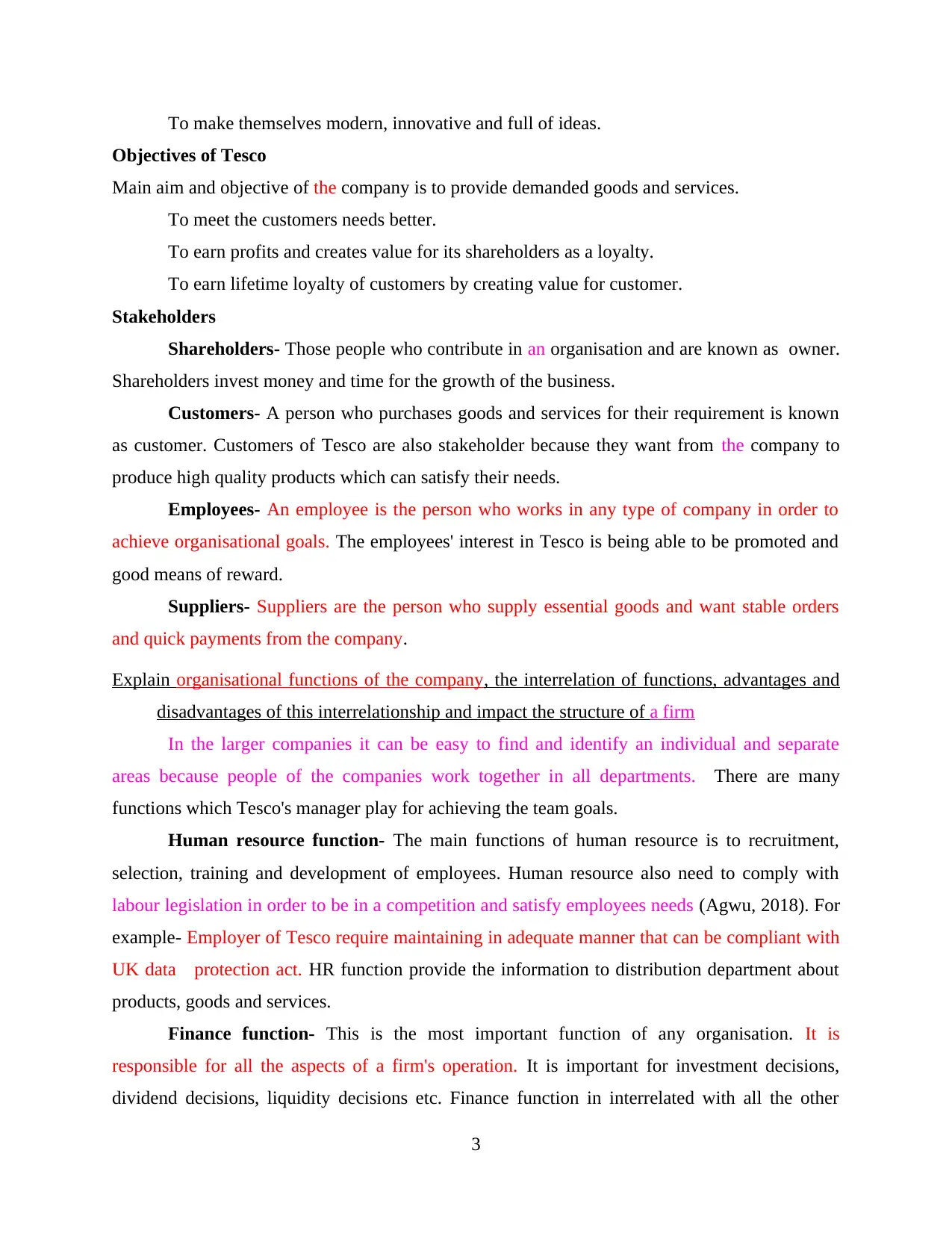
To make themselves modern, innovative and full of ideas.
Objectives of Tesco
Main aim and objective of the company is to provide demanded goods and services.
To meet the customers needs better.
To earn profits and creates value for its shareholders as a loyalty.
To earn lifetime loyalty of customers by creating value for customer.
Stakeholders
Shareholders- Those people who contribute in an organisation and are known as owner.
Shareholders invest money and time for the growth of the business.
Customers- A person who purchases goods and services for their requirement is known
as customer. Customers of Tesco are also stakeholder because they want from the company to
produce high quality products which can satisfy their needs.
Employees- An employee is the person who works in any type of company in order to
achieve organisational goals. The employees' interest in Tesco is being able to be promoted and
good means of reward.
Suppliers- Suppliers are the person who supply essential goods and want stable orders
and quick payments from the company.
Explain organisational functions of the company, the interrelation of functions, advantages and
disadvantages of this interrelationship and impact the structure of a firm
In the larger companies it can be easy to find and identify an individual and separate
areas because people of the companies work together in all departments. There are many
functions which Tesco's manager play for achieving the team goals.
Human resource function- The main functions of human resource is to recruitment,
selection, training and development of employees. Human resource also need to comply with
labour legislation in order to be in a competition and satisfy employees needs (Agwu, 2018). For
example- Employer of Tesco require maintaining in adequate manner that can be compliant with
UK data protection act. HR function provide the information to distribution department about
products, goods and services.
Finance function- This is the most important function of any organisation. It is
responsible for all the aspects of a firm's operation. It is important for investment decisions,
dividend decisions, liquidity decisions etc. Finance function in interrelated with all the other
3
Objectives of Tesco
Main aim and objective of the company is to provide demanded goods and services.
To meet the customers needs better.
To earn profits and creates value for its shareholders as a loyalty.
To earn lifetime loyalty of customers by creating value for customer.
Stakeholders
Shareholders- Those people who contribute in an organisation and are known as owner.
Shareholders invest money and time for the growth of the business.
Customers- A person who purchases goods and services for their requirement is known
as customer. Customers of Tesco are also stakeholder because they want from the company to
produce high quality products which can satisfy their needs.
Employees- An employee is the person who works in any type of company in order to
achieve organisational goals. The employees' interest in Tesco is being able to be promoted and
good means of reward.
Suppliers- Suppliers are the person who supply essential goods and want stable orders
and quick payments from the company.
Explain organisational functions of the company, the interrelation of functions, advantages and
disadvantages of this interrelationship and impact the structure of a firm
In the larger companies it can be easy to find and identify an individual and separate
areas because people of the companies work together in all departments. There are many
functions which Tesco's manager play for achieving the team goals.
Human resource function- The main functions of human resource is to recruitment,
selection, training and development of employees. Human resource also need to comply with
labour legislation in order to be in a competition and satisfy employees needs (Agwu, 2018). For
example- Employer of Tesco require maintaining in adequate manner that can be compliant with
UK data protection act. HR function provide the information to distribution department about
products, goods and services.
Finance function- This is the most important function of any organisation. It is
responsible for all the aspects of a firm's operation. It is important for investment decisions,
dividend decisions, liquidity decisions etc. Finance function in interrelated with all the other
3
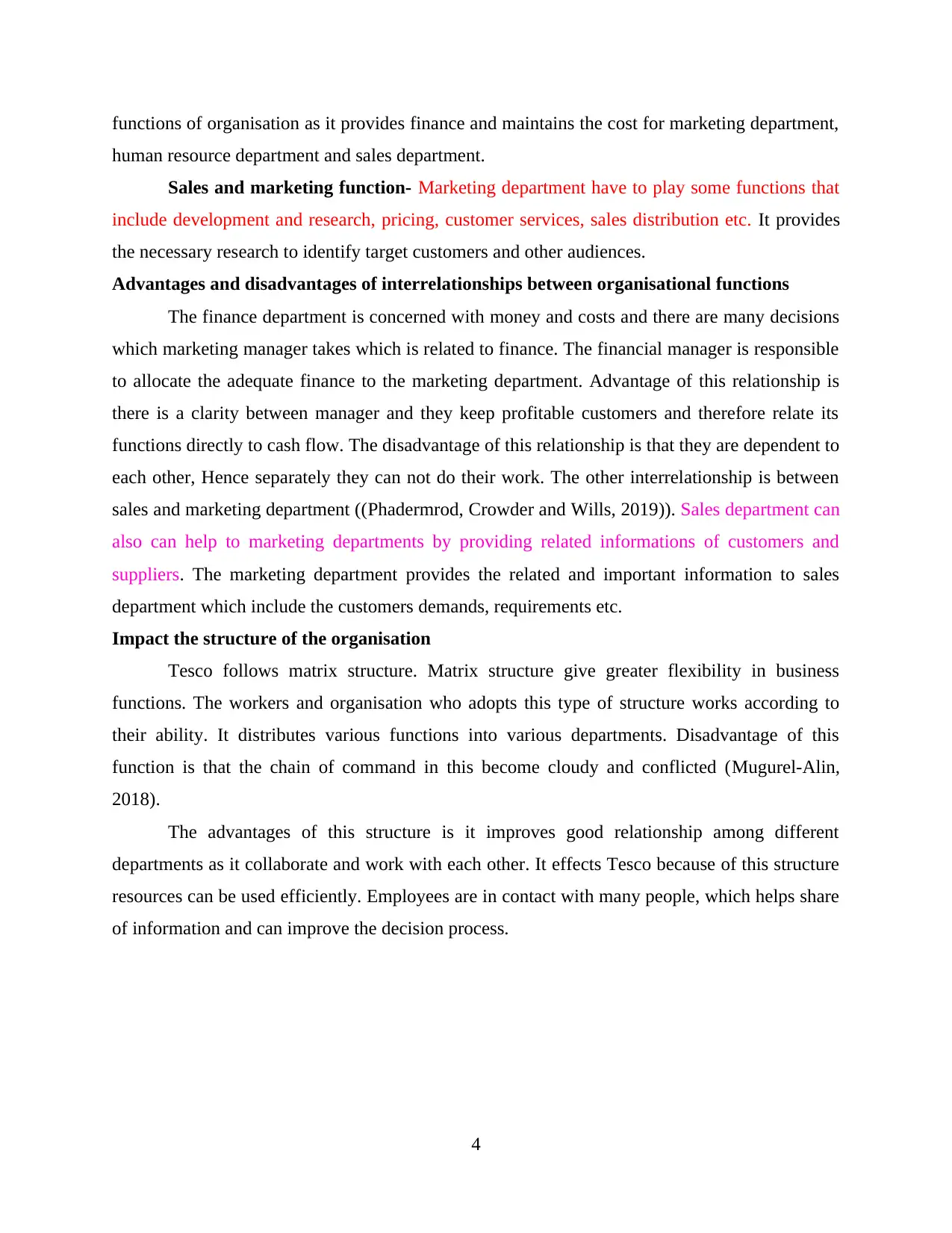
functions of organisation as it provides finance and maintains the cost for marketing department,
human resource department and sales department.
Sales and marketing function- Marketing department have to play some functions that
include development and research, pricing, customer services, sales distribution etc. It provides
the necessary research to identify target customers and other audiences.
Advantages and disadvantages of interrelationships between organisational functions
The finance department is concerned with money and costs and there are many decisions
which marketing manager takes which is related to finance. The financial manager is responsible
to allocate the adequate finance to the marketing department. Advantage of this relationship is
there is a clarity between manager and they keep profitable customers and therefore relate its
functions directly to cash flow. The disadvantage of this relationship is that they are dependent to
each other, Hence separately they can not do their work. The other interrelationship is between
sales and marketing department ((Phadermrod, Crowder and Wills, 2019)). Sales department can
also can help to marketing departments by providing related informations of customers and
suppliers. The marketing department provides the related and important information to sales
department which include the customers demands, requirements etc.
Impact the structure of the organisation
Tesco follows matrix structure. Matrix structure give greater flexibility in business
functions. The workers and organisation who adopts this type of structure works according to
their ability. It distributes various functions into various departments. Disadvantage of this
function is that the chain of command in this become cloudy and conflicted (Mugurel-Alin,
2018).
The advantages of this structure is it improves good relationship among different
departments as it collaborate and work with each other. It effects Tesco because of this structure
resources can be used efficiently. Employees are in contact with many people, which helps share
of information and can improve the decision process.
4
human resource department and sales department.
Sales and marketing function- Marketing department have to play some functions that
include development and research, pricing, customer services, sales distribution etc. It provides
the necessary research to identify target customers and other audiences.
Advantages and disadvantages of interrelationships between organisational functions
The finance department is concerned with money and costs and there are many decisions
which marketing manager takes which is related to finance. The financial manager is responsible
to allocate the adequate finance to the marketing department. Advantage of this relationship is
there is a clarity between manager and they keep profitable customers and therefore relate its
functions directly to cash flow. The disadvantage of this relationship is that they are dependent to
each other, Hence separately they can not do their work. The other interrelationship is between
sales and marketing department ((Phadermrod, Crowder and Wills, 2019)). Sales department can
also can help to marketing departments by providing related informations of customers and
suppliers. The marketing department provides the related and important information to sales
department which include the customers demands, requirements etc.
Impact the structure of the organisation
Tesco follows matrix structure. Matrix structure give greater flexibility in business
functions. The workers and organisation who adopts this type of structure works according to
their ability. It distributes various functions into various departments. Disadvantage of this
function is that the chain of command in this become cloudy and conflicted (Mugurel-Alin,
2018).
The advantages of this structure is it improves good relationship among different
departments as it collaborate and work with each other. It effects Tesco because of this structure
resources can be used efficiently. Employees are in contact with many people, which helps share
of information and can improve the decision process.
4
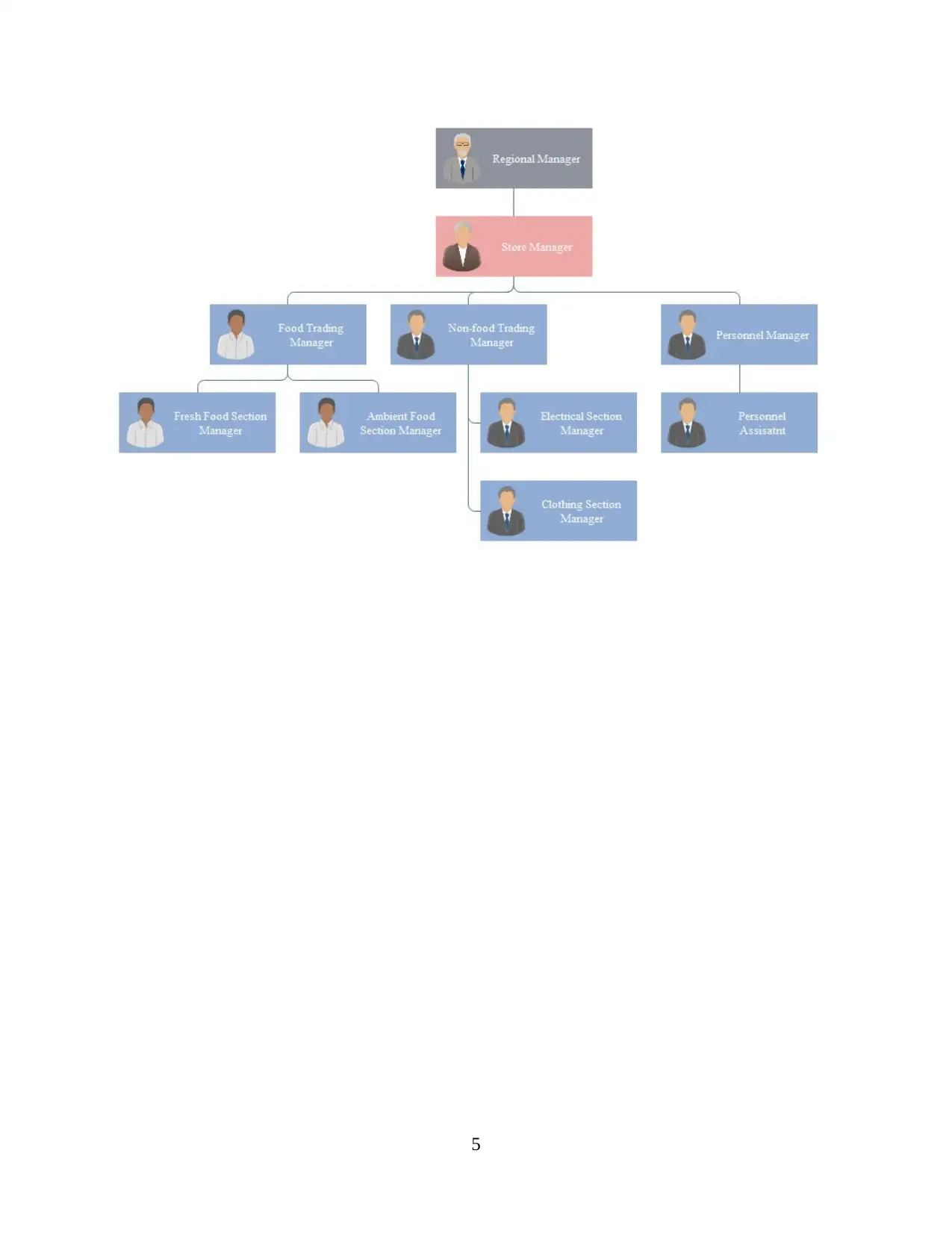
5
Paraphrase This Document
Need a fresh take? Get an instant paraphrase of this document with our AI Paraphraser
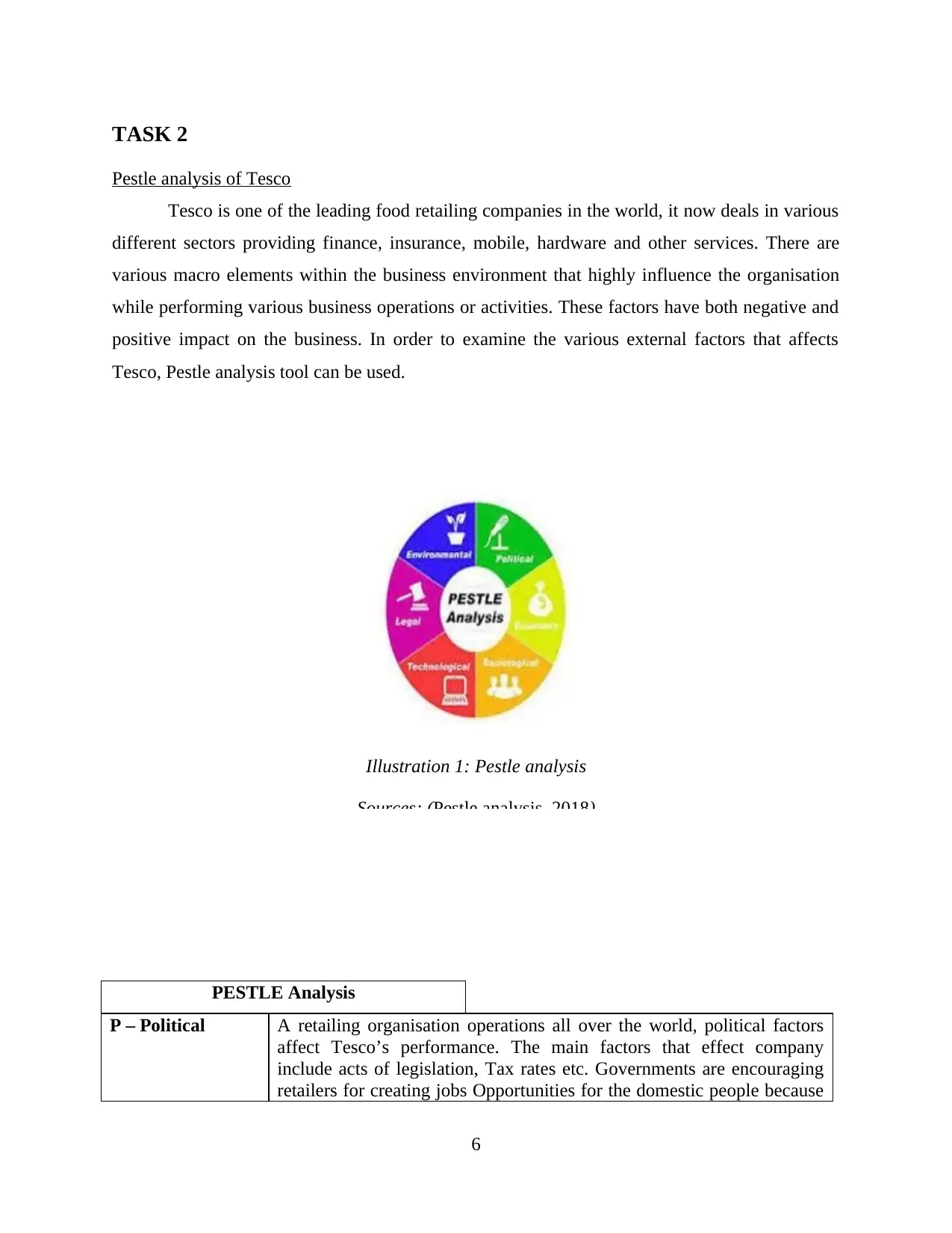
TASK 2
Pestle analysis of Tesco
Tesco is one of the leading food retailing companies in the world, it now deals in various
different sectors providing finance, insurance, mobile, hardware and other services. There are
various macro elements within the business environment that highly influence the organisation
while performing various business operations or activities. These factors have both negative and
positive impact on the business. In order to examine the various external factors that affects
Tesco, Pestle analysis tool can be used.
PESTLE Analysis
P – Political A retailing organisation operations all over the world, political factors
affect Tesco’s performance. The main factors that effect company
include acts of legislation, Tax rates etc. Governments are encouraging
retailers for creating jobs Opportunities for the domestic people because
6
Illustration 1: Pestle analysis
Sources: (Pestle analysis, 2018)
Pestle analysis of Tesco
Tesco is one of the leading food retailing companies in the world, it now deals in various
different sectors providing finance, insurance, mobile, hardware and other services. There are
various macro elements within the business environment that highly influence the organisation
while performing various business operations or activities. These factors have both negative and
positive impact on the business. In order to examine the various external factors that affects
Tesco, Pestle analysis tool can be used.
PESTLE Analysis
P – Political A retailing organisation operations all over the world, political factors
affect Tesco’s performance. The main factors that effect company
include acts of legislation, Tax rates etc. Governments are encouraging
retailers for creating jobs Opportunities for the domestic people because
6
Illustration 1: Pestle analysis
Sources: (Pestle analysis, 2018)
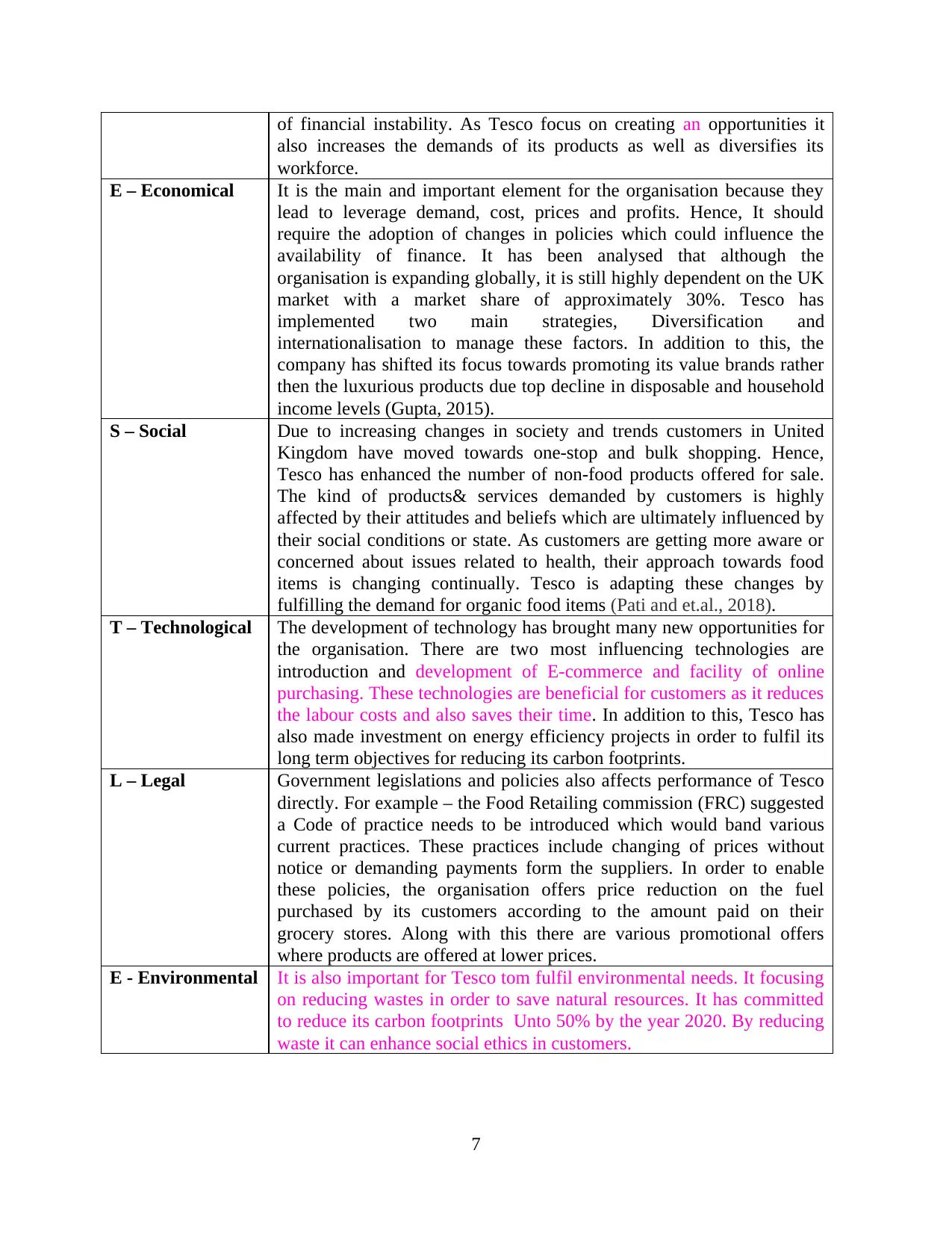
of financial instability. As Tesco focus on creating an opportunities it
also increases the demands of its products as well as diversifies its
workforce.
E – Economical It is the main and important element for the organisation because they
lead to leverage demand, cost, prices and profits. Hence, It should
require the adoption of changes in policies which could influence the
availability of finance. It has been analysed that although the
organisation is expanding globally, it is still highly dependent on the UK
market with a market share of approximately 30%. Tesco has
implemented two main strategies, Diversification and
internationalisation to manage these factors. In addition to this, the
company has shifted its focus towards promoting its value brands rather
then the luxurious products due top decline in disposable and household
income levels (Gupta, 2015).
S – Social Due to increasing changes in society and trends customers in United
Kingdom have moved towards one-stop and bulk shopping. Hence,
Tesco has enhanced the number of non-food products offered for sale.
The kind of products& services demanded by customers is highly
affected by their attitudes and beliefs which are ultimately influenced by
their social conditions or state. As customers are getting more aware or
concerned about issues related to health, their approach towards food
items is changing continually. Tesco is adapting these changes by
fulfilling the demand for organic food items (Pati and et.al., 2018).
T – Technological The development of technology has brought many new opportunities for
the organisation. There are two most influencing technologies are
introduction and development of E-commerce and facility of online
purchasing. These technologies are beneficial for customers as it reduces
the labour costs and also saves their time. In addition to this, Tesco has
also made investment on energy efficiency projects in order to fulfil its
long term objectives for reducing its carbon footprints.
L – Legal Government legislations and policies also affects performance of Tesco
directly. For example – the Food Retailing commission (FRC) suggested
a Code of practice needs to be introduced which would band various
current practices. These practices include changing of prices without
notice or demanding payments form the suppliers. In order to enable
these policies, the organisation offers price reduction on the fuel
purchased by its customers according to the amount paid on their
grocery stores. Along with this there are various promotional offers
where products are offered at lower prices.
E - Environmental It is also important for Tesco tom fulfil environmental needs. It focusing
on reducing wastes in order to save natural resources. It has committed
to reduce its carbon footprints Unto 50% by the year 2020. By reducing
waste it can enhance social ethics in customers.
7
also increases the demands of its products as well as diversifies its
workforce.
E – Economical It is the main and important element for the organisation because they
lead to leverage demand, cost, prices and profits. Hence, It should
require the adoption of changes in policies which could influence the
availability of finance. It has been analysed that although the
organisation is expanding globally, it is still highly dependent on the UK
market with a market share of approximately 30%. Tesco has
implemented two main strategies, Diversification and
internationalisation to manage these factors. In addition to this, the
company has shifted its focus towards promoting its value brands rather
then the luxurious products due top decline in disposable and household
income levels (Gupta, 2015).
S – Social Due to increasing changes in society and trends customers in United
Kingdom have moved towards one-stop and bulk shopping. Hence,
Tesco has enhanced the number of non-food products offered for sale.
The kind of products& services demanded by customers is highly
affected by their attitudes and beliefs which are ultimately influenced by
their social conditions or state. As customers are getting more aware or
concerned about issues related to health, their approach towards food
items is changing continually. Tesco is adapting these changes by
fulfilling the demand for organic food items (Pati and et.al., 2018).
T – Technological The development of technology has brought many new opportunities for
the organisation. There are two most influencing technologies are
introduction and development of E-commerce and facility of online
purchasing. These technologies are beneficial for customers as it reduces
the labour costs and also saves their time. In addition to this, Tesco has
also made investment on energy efficiency projects in order to fulfil its
long term objectives for reducing its carbon footprints.
L – Legal Government legislations and policies also affects performance of Tesco
directly. For example – the Food Retailing commission (FRC) suggested
a Code of practice needs to be introduced which would band various
current practices. These practices include changing of prices without
notice or demanding payments form the suppliers. In order to enable
these policies, the organisation offers price reduction on the fuel
purchased by its customers according to the amount paid on their
grocery stores. Along with this there are various promotional offers
where products are offered at lower prices.
E - Environmental It is also important for Tesco tom fulfil environmental needs. It focusing
on reducing wastes in order to save natural resources. It has committed
to reduce its carbon footprints Unto 50% by the year 2020. By reducing
waste it can enhance social ethics in customers.
7
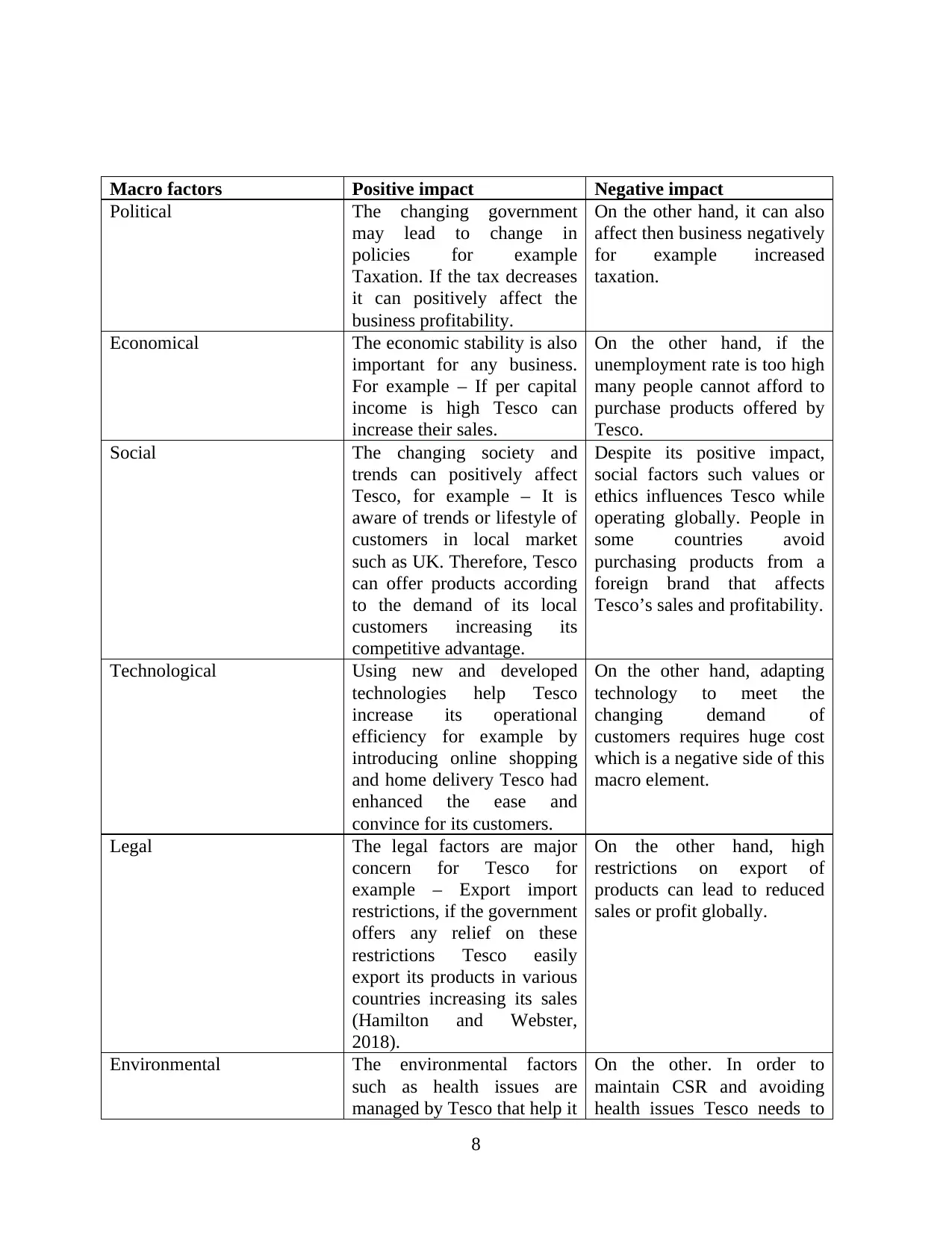
Macro factors Positive impact Negative impact
Political The changing government
may lead to change in
policies for example
Taxation. If the tax decreases
it can positively affect the
business profitability.
On the other hand, it can also
affect then business negatively
for example increased
taxation.
Economical The economic stability is also
important for any business.
For example – If per capital
income is high Tesco can
increase their sales.
On the other hand, if the
unemployment rate is too high
many people cannot afford to
purchase products offered by
Tesco.
Social The changing society and
trends can positively affect
Tesco, for example – It is
aware of trends or lifestyle of
customers in local market
such as UK. Therefore, Tesco
can offer products according
to the demand of its local
customers increasing its
competitive advantage.
Despite its positive impact,
social factors such values or
ethics influences Tesco while
operating globally. People in
some countries avoid
purchasing products from a
foreign brand that affects
Tesco’s sales and profitability.
Technological Using new and developed
technologies help Tesco
increase its operational
efficiency for example by
introducing online shopping
and home delivery Tesco had
enhanced the ease and
convince for its customers.
On the other hand, adapting
technology to meet the
changing demand of
customers requires huge cost
which is a negative side of this
macro element.
Legal The legal factors are major
concern for Tesco for
example – Export import
restrictions, if the government
offers any relief on these
restrictions Tesco easily
export its products in various
countries increasing its sales
(Hamilton and Webster,
2018).
On the other hand, high
restrictions on export of
products can lead to reduced
sales or profit globally.
Environmental The environmental factors
such as health issues are
managed by Tesco that help it
On the other. In order to
maintain CSR and avoiding
health issues Tesco needs to
8
Political The changing government
may lead to change in
policies for example
Taxation. If the tax decreases
it can positively affect the
business profitability.
On the other hand, it can also
affect then business negatively
for example increased
taxation.
Economical The economic stability is also
important for any business.
For example – If per capital
income is high Tesco can
increase their sales.
On the other hand, if the
unemployment rate is too high
many people cannot afford to
purchase products offered by
Tesco.
Social The changing society and
trends can positively affect
Tesco, for example – It is
aware of trends or lifestyle of
customers in local market
such as UK. Therefore, Tesco
can offer products according
to the demand of its local
customers increasing its
competitive advantage.
Despite its positive impact,
social factors such values or
ethics influences Tesco while
operating globally. People in
some countries avoid
purchasing products from a
foreign brand that affects
Tesco’s sales and profitability.
Technological Using new and developed
technologies help Tesco
increase its operational
efficiency for example by
introducing online shopping
and home delivery Tesco had
enhanced the ease and
convince for its customers.
On the other hand, adapting
technology to meet the
changing demand of
customers requires huge cost
which is a negative side of this
macro element.
Legal The legal factors are major
concern for Tesco for
example – Export import
restrictions, if the government
offers any relief on these
restrictions Tesco easily
export its products in various
countries increasing its sales
(Hamilton and Webster,
2018).
On the other hand, high
restrictions on export of
products can lead to reduced
sales or profit globally.
Environmental The environmental factors
such as health issues are
managed by Tesco that help it
On the other. In order to
maintain CSR and avoiding
health issues Tesco needs to
8
Secure Best Marks with AI Grader
Need help grading? Try our AI Grader for instant feedback on your assignments.
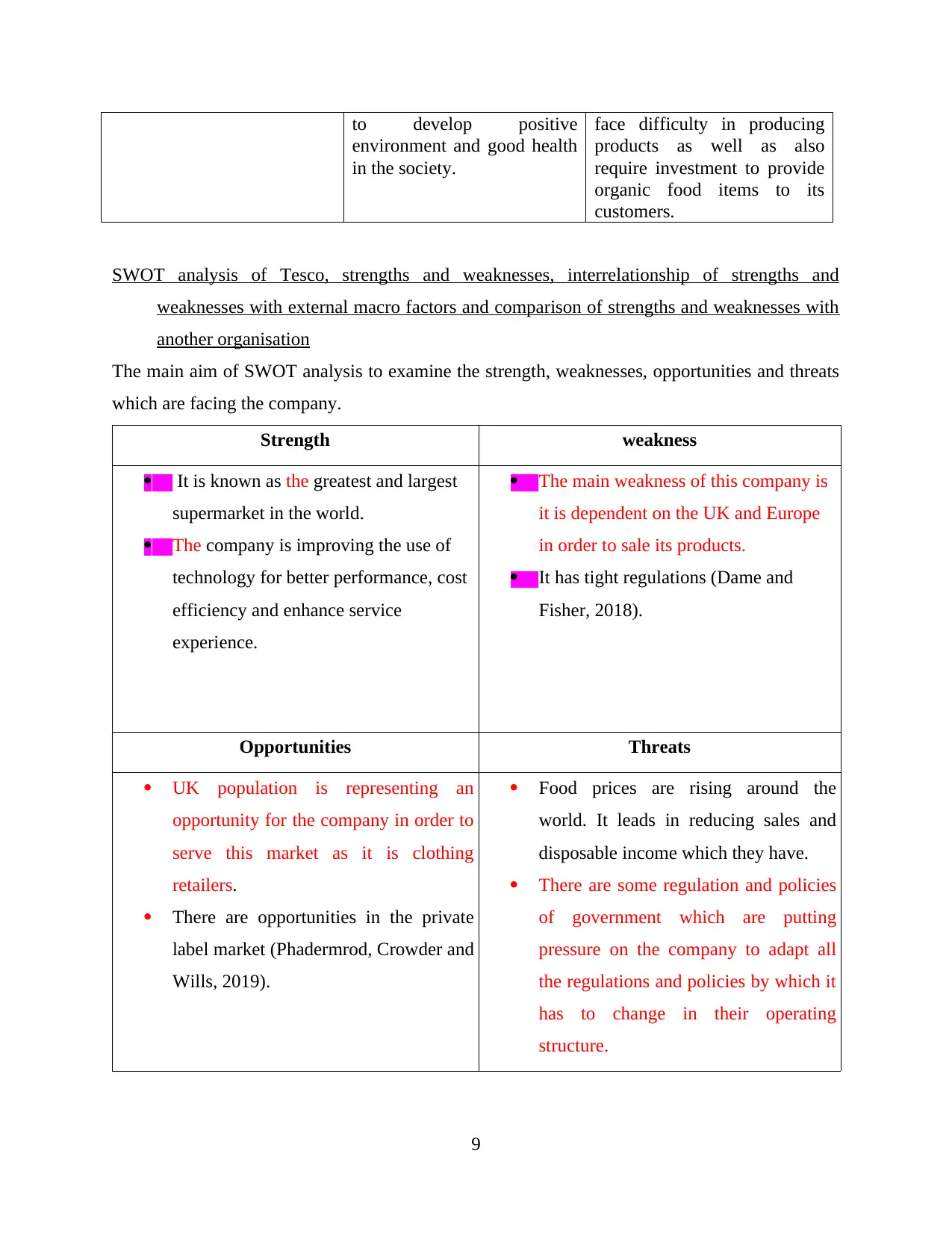
to develop positive
environment and good health
in the society.
face difficulty in producing
products as well as also
require investment to provide
organic food items to its
customers.
SWOT analysis of Tesco, strengths and weaknesses, interrelationship of strengths and
weaknesses with external macro factors and comparison of strengths and weaknesses with
another organisation
The main aim of SWOT analysis to examine the strength, weaknesses, opportunities and threats
which are facing the company.
Strength weakness
It is known as the greatest and largest
supermarket in the world.
The company is improving the use of
technology for better performance, cost
efficiency and enhance service
experience.
The main weakness of this company is
it is dependent on the UK and Europe
in order to sale its products.
It has tight regulations (Dame and
Fisher, 2018).
Opportunities Threats
UK population is representing an
opportunity for the company in order to
serve this market as it is clothing
retailers.
There are opportunities in the private
label market (Phadermrod, Crowder and
Wills, 2019).
Food prices are rising around the
world. It leads in reducing sales and
disposable income which they have.
There are some regulation and policies
of government which are putting
pressure on the company to adapt all
the regulations and policies by which it
has to change in their operating
structure.
9
environment and good health
in the society.
face difficulty in producing
products as well as also
require investment to provide
organic food items to its
customers.
SWOT analysis of Tesco, strengths and weaknesses, interrelationship of strengths and
weaknesses with external macro factors and comparison of strengths and weaknesses with
another organisation
The main aim of SWOT analysis to examine the strength, weaknesses, opportunities and threats
which are facing the company.
Strength weakness
It is known as the greatest and largest
supermarket in the world.
The company is improving the use of
technology for better performance, cost
efficiency and enhance service
experience.
The main weakness of this company is
it is dependent on the UK and Europe
in order to sale its products.
It has tight regulations (Dame and
Fisher, 2018).
Opportunities Threats
UK population is representing an
opportunity for the company in order to
serve this market as it is clothing
retailers.
There are opportunities in the private
label market (Phadermrod, Crowder and
Wills, 2019).
Food prices are rising around the
world. It leads in reducing sales and
disposable income which they have.
There are some regulation and policies
of government which are putting
pressure on the company to adapt all
the regulations and policies by which it
has to change in their operating
structure.
9

Interrelation of the strengths and weaknesses with external macro factors
Social factors like changing society trends affects Tesco company. Organisation makes
good and effective products for satisfying their customers needs. It focuses on making healthy
food in order to resolve health issues. By social environment strategy, company may benefit
themselves by providing the best services and different services from their competitors.
The weaknesses for the company is new policies and regulations by which it can not
expand its business. Political and environmental factors are the reason of Tesco's weakness. The
business contraction strategy has influenced the business rise of retail shop (Arif, Khan and Ali
Raza, 2018). On the other hand economic environment is different in various type countries. So
Tesco get the opportunities from the free global market in political and economic environment.
Comparison of strength and weaknesses of Tesco with another organisation
Tesco Sainsbury
It operates 7,000 stores around the world. It has 600 supermarkets and over 800
convenience stores across UK.
It has tight regulation and have very low
knowledge of brand.
Stiff competition within every segment of the
retail sector.
It has strong financial position and innovation. This company is listed on the London stock
exchange and FTSE index.
Critical reflection of key findings and evaluation the impact on decision-making
Strength and weakness of Tesco affects the decision-making process of company.
Strength of company is operates almost 7,000 stores around the world. It is one of the largest
food retailer in the world so it positively affects Tesco in decision-making process as it increases
the sales and profit of company. There are almost 40,000 products are sold by company.
According to social factors it fulfils the all needs of customers by making the good and healthy
food (Agwu, 2018).
The political and economic factors affect negatively to decision-making process.
Economic factors influence demand costs, prices and profits. The main economic factor is
unemployment rate and level that can decrease the demands of the goods and products of the
company.
10
Social factors like changing society trends affects Tesco company. Organisation makes
good and effective products for satisfying their customers needs. It focuses on making healthy
food in order to resolve health issues. By social environment strategy, company may benefit
themselves by providing the best services and different services from their competitors.
The weaknesses for the company is new policies and regulations by which it can not
expand its business. Political and environmental factors are the reason of Tesco's weakness. The
business contraction strategy has influenced the business rise of retail shop (Arif, Khan and Ali
Raza, 2018). On the other hand economic environment is different in various type countries. So
Tesco get the opportunities from the free global market in political and economic environment.
Comparison of strength and weaknesses of Tesco with another organisation
Tesco Sainsbury
It operates 7,000 stores around the world. It has 600 supermarkets and over 800
convenience stores across UK.
It has tight regulation and have very low
knowledge of brand.
Stiff competition within every segment of the
retail sector.
It has strong financial position and innovation. This company is listed on the London stock
exchange and FTSE index.
Critical reflection of key findings and evaluation the impact on decision-making
Strength and weakness of Tesco affects the decision-making process of company.
Strength of company is operates almost 7,000 stores around the world. It is one of the largest
food retailer in the world so it positively affects Tesco in decision-making process as it increases
the sales and profit of company. There are almost 40,000 products are sold by company.
According to social factors it fulfils the all needs of customers by making the good and healthy
food (Agwu, 2018).
The political and economic factors affect negatively to decision-making process.
Economic factors influence demand costs, prices and profits. The main economic factor is
unemployment rate and level that can decrease the demands of the goods and products of the
company.
10
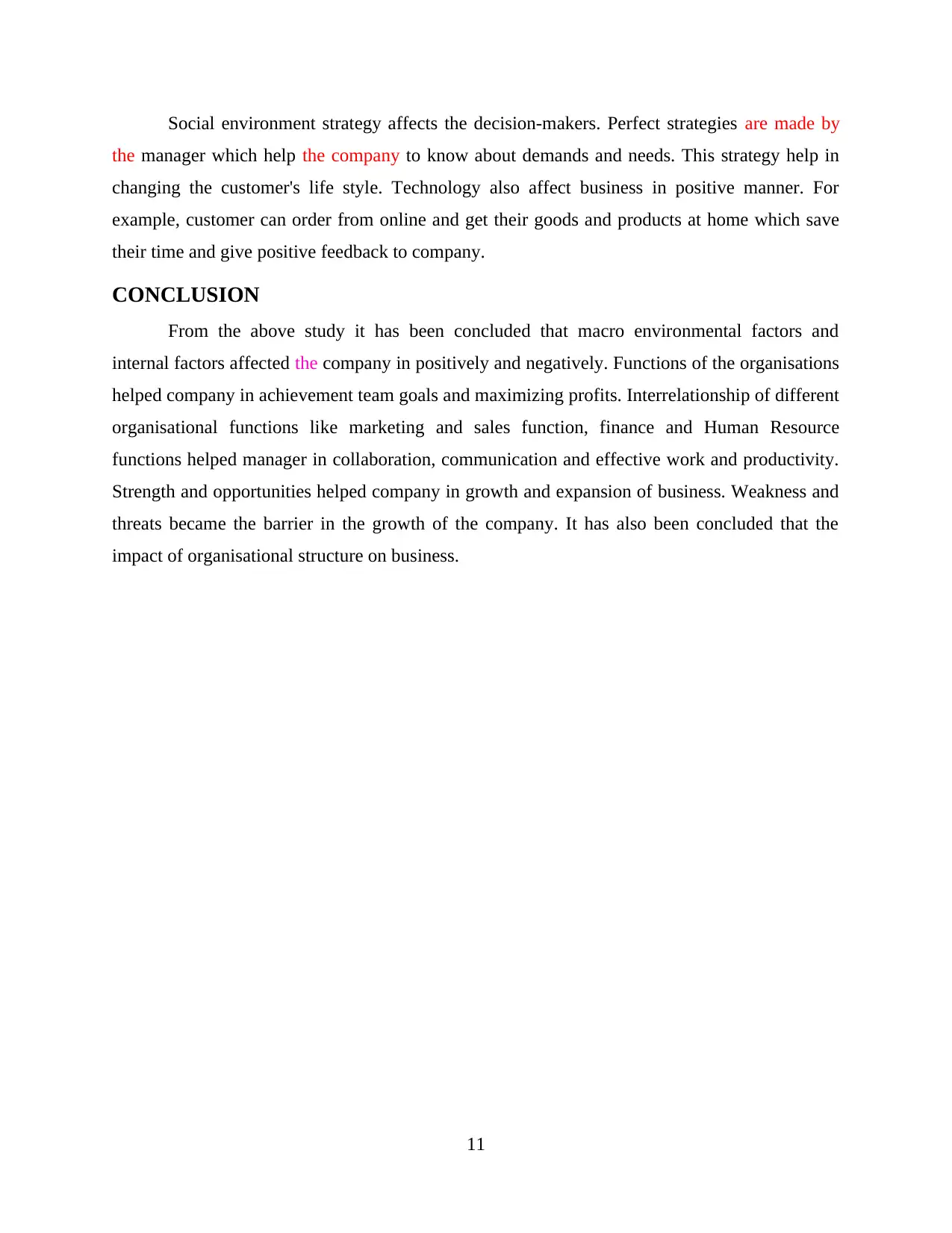
Social environment strategy affects the decision-makers. Perfect strategies are made by
the manager which help the company to know about demands and needs. This strategy help in
changing the customer's life style. Technology also affect business in positive manner. For
example, customer can order from online and get their goods and products at home which save
their time and give positive feedback to company.
CONCLUSION
From the above study it has been concluded that macro environmental factors and
internal factors affected the company in positively and negatively. Functions of the organisations
helped company in achievement team goals and maximizing profits. Interrelationship of different
organisational functions like marketing and sales function, finance and Human Resource
functions helped manager in collaboration, communication and effective work and productivity.
Strength and opportunities helped company in growth and expansion of business. Weakness and
threats became the barrier in the growth of the company. It has also been concluded that the
impact of organisational structure on business.
11
the manager which help the company to know about demands and needs. This strategy help in
changing the customer's life style. Technology also affect business in positive manner. For
example, customer can order from online and get their goods and products at home which save
their time and give positive feedback to company.
CONCLUSION
From the above study it has been concluded that macro environmental factors and
internal factors affected the company in positively and negatively. Functions of the organisations
helped company in achievement team goals and maximizing profits. Interrelationship of different
organisational functions like marketing and sales function, finance and Human Resource
functions helped manager in collaboration, communication and effective work and productivity.
Strength and opportunities helped company in growth and expansion of business. Weakness and
threats became the barrier in the growth of the company. It has also been concluded that the
impact of organisational structure on business.
11
Paraphrase This Document
Need a fresh take? Get an instant paraphrase of this document with our AI Paraphraser
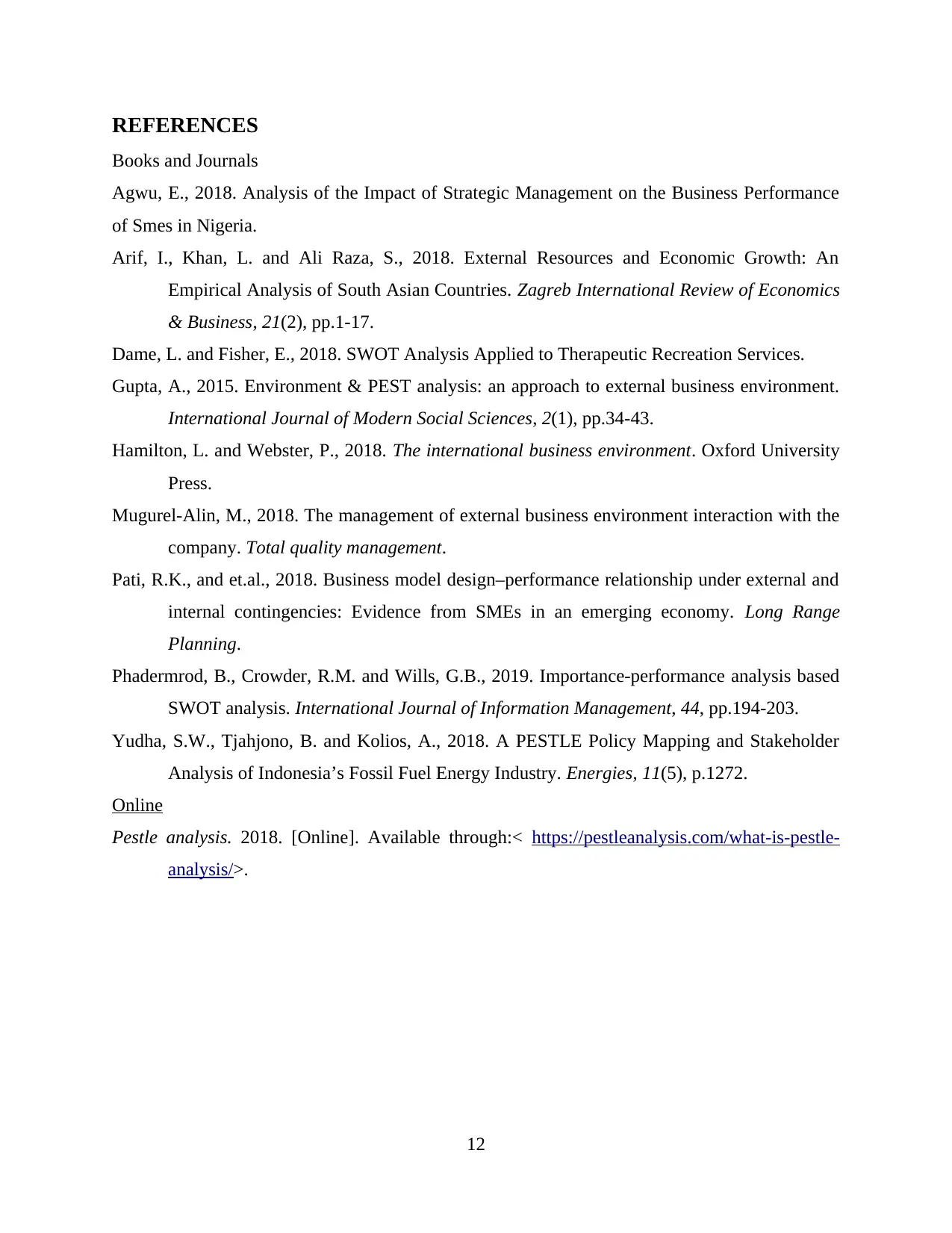
REFERENCES
Books and Journals
Agwu, E., 2018. Analysis of the Impact of Strategic Management on the Business Performance
of Smes in Nigeria.
Arif, I., Khan, L. and Ali Raza, S., 2018. External Resources and Economic Growth: An
Empirical Analysis of South Asian Countries. Zagreb International Review of Economics
& Business, 21(2), pp.1-17.
Dame, L. and Fisher, E., 2018. SWOT Analysis Applied to Therapeutic Recreation Services.
Gupta, A., 2015. Environment & PEST analysis: an approach to external business environment.
International Journal of Modern Social Sciences, 2(1), pp.34-43.
Hamilton, L. and Webster, P., 2018. The international business environment. Oxford University
Press.
Mugurel-Alin, M., 2018. The management of external business environment interaction with the
company. Total quality management.
Pati, R.K., and et.al., 2018. Business model design–performance relationship under external and
internal contingencies: Evidence from SMEs in an emerging economy. Long Range
Planning.
Phadermrod, B., Crowder, R.M. and Wills, G.B., 2019. Importance-performance analysis based
SWOT analysis. International Journal of Information Management, 44, pp.194-203.
Yudha, S.W., Tjahjono, B. and Kolios, A., 2018. A PESTLE Policy Mapping and Stakeholder
Analysis of Indonesia’s Fossil Fuel Energy Industry. Energies, 11(5), p.1272.
Online
Pestle analysis. 2018. [Online]. Available through:< https://pestleanalysis.com/what-is-pestle-
analysis/>.
12
Books and Journals
Agwu, E., 2018. Analysis of the Impact of Strategic Management on the Business Performance
of Smes in Nigeria.
Arif, I., Khan, L. and Ali Raza, S., 2018. External Resources and Economic Growth: An
Empirical Analysis of South Asian Countries. Zagreb International Review of Economics
& Business, 21(2), pp.1-17.
Dame, L. and Fisher, E., 2018. SWOT Analysis Applied to Therapeutic Recreation Services.
Gupta, A., 2015. Environment & PEST analysis: an approach to external business environment.
International Journal of Modern Social Sciences, 2(1), pp.34-43.
Hamilton, L. and Webster, P., 2018. The international business environment. Oxford University
Press.
Mugurel-Alin, M., 2018. The management of external business environment interaction with the
company. Total quality management.
Pati, R.K., and et.al., 2018. Business model design–performance relationship under external and
internal contingencies: Evidence from SMEs in an emerging economy. Long Range
Planning.
Phadermrod, B., Crowder, R.M. and Wills, G.B., 2019. Importance-performance analysis based
SWOT analysis. International Journal of Information Management, 44, pp.194-203.
Yudha, S.W., Tjahjono, B. and Kolios, A., 2018. A PESTLE Policy Mapping and Stakeholder
Analysis of Indonesia’s Fossil Fuel Energy Industry. Energies, 11(5), p.1272.
Online
Pestle analysis. 2018. [Online]. Available through:< https://pestleanalysis.com/what-is-pestle-
analysis/>.
12
1 out of 14
Related Documents
Your All-in-One AI-Powered Toolkit for Academic Success.
+13062052269
info@desklib.com
Available 24*7 on WhatsApp / Email
![[object Object]](/_next/static/media/star-bottom.7253800d.svg)
Unlock your academic potential
© 2024 | Zucol Services PVT LTD | All rights reserved.





